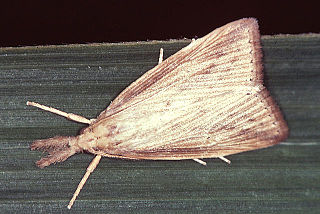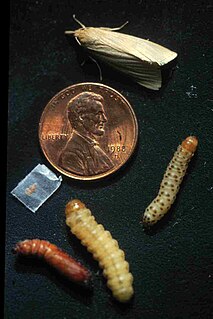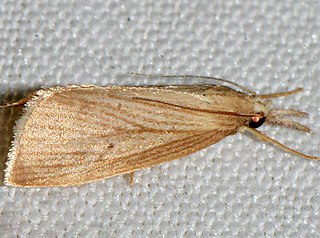
The Crambidae are the grass moth family of lepidopterans. They are variable in appearance, the nominal subfamily Crambinae taking up closely folded postures on grass stems where they are inconspicuous, while other subfamilies include brightly coloured and patterned insects which rest in wing-spread attitudes.

Diatraea is a genus of moths of the family Crambidae.

Diatraea saccharalis, the sugarcane borer, is a species of moth of the family Crambidae. It was described by Johan Christian Fabricius in 1794. It is native to the Caribbean, Central America, and the warmer parts of South America south to northern Argentina. It was introduced to Louisiana in about 1855, and has since spread to the other Gulf Coast states.

The southwestern corn borer, Diatraea grandiosella, is a moth belonging to the sub-order Heterocera. Like most moths, The southwestern corn borer undergoes complete metamorphosis developing as an egg, larva (caterpillar), pupa and adult. It is capable of entering diapause in its larva stage and under the conditions of a precise photoperiod. Growth and development are regulated by juvenile hormones. The southwestern corn borer has an extensive range. It occurs in Mexico and in Alabama, Arizona, Arkansas, Colorado, Illinois, Indiana, Kansas, Kentucky, Louisiana, Mississippi, Missouri, Nebraska, New Mexico, Oklahoma, Tennessee, and Texas.

Diatraea crambidoides, the southern cornstalk borer moth, is a species of moth of the family Crambidae described by Augustus Radcliffe Grote in 1880. It is found in North America, from Alabama and northern Florida to Ohio and Maryland. Its wingspan is 15–40 mm, and adults are straw colored to dull white. The forewings are slightly darker than the hindwings. There are two generations per year.
Diatraea andina is a moth in the family Crambidae. It was described by Harold Edmund Box in 1951. It is found in Venezuela.
Diatraea bellifactella is a moth in the family Crambidae. It was described by Harrison Gray Dyar Jr. in 1911. It is found in Brazilian states of São Paulo and Parana and Panama.
Diatraea minimifacta is a moth in the family Crambidae. It was described by Harrison Gray Dyar Jr. in 1911. It is found in Trinidad and Tobago, Costa Rica, Mexico (Tabasco) and Venezuela.
Diatraea strigipennella is a moth in the family Crambidae. It was described by Harrison Gray Dyar Jr. in 1911. It is found in the Guianas, Brazil and Argentina.
Diatraea busckella is a moth in the family Crambidae. It was described by Harrison Gray Dyar Jr. and Carl Heinrich in 1927. It is found in Panama, Ecuador, Colombia and Venezuela.
Diatraea castrensis is a moth in the family Crambidae. It was described by Harrison Gray Dyar Jr. and Carl Heinrich in 1927. It is found in Paraná, Brazil.
Diatraea muellerella is a moth in the family Crambidae. It was described by Harrison Gray Dyar Jr. and Carl Heinrich in 1927. It is found in Guerrero, Mexico.
Diatraea maronialis is a moth in the family Crambidae. It was described by Schaus in 1922. It is found in French Guiana.
Diatraea postlineella is a moth in the family Crambidae. It was described by Schaus in 1922. It is found in Guatemala.
Diatraea centrellus is a moth in the family Crambidae. It was described by Heinrich Benno Möschler in 1883. It is found in Grenada, Suriname, French Guiana and Brazil.

Diatraea evanescens is a moth in the family Crambidae. It was described by Harrison Gray Dyar Jr. in 1917. It is found in the US states of Alabama, Arkansas, Florida, Georgia, Louisiana, Maryland, Mississippi, North Carolina, Ohio, Oklahoma, South Carolina, Tennessee and Texas.
Diatraea lativittalis is a moth in the family Crambidae. It was described by Paul Dognin in 1910. It is found in Argentina.

Diatraea lisetta is a moth in the family Crambidae. It was described by Harrison Gray Dyar Jr. in 1909. It is found in Panama, Mexico and the United States, where it has been recorded from Alabama, Florida, Georgia, Louisiana, Maryland, Mississippi, South Carolina, Tennessee and Virginia.
Diatraea venosalis is a moth in the family Crambidae. It was described by Harrison Gray Dyar Jr. in 1917. It is found in the US states of Louisiana and Oklahoma.
Diatraea mitteri is a moth in the family Crambidae. It was described by Solis in 2015. It is found in the United States, where it has been recorded from Kansas, Oklahoma and Texas.





